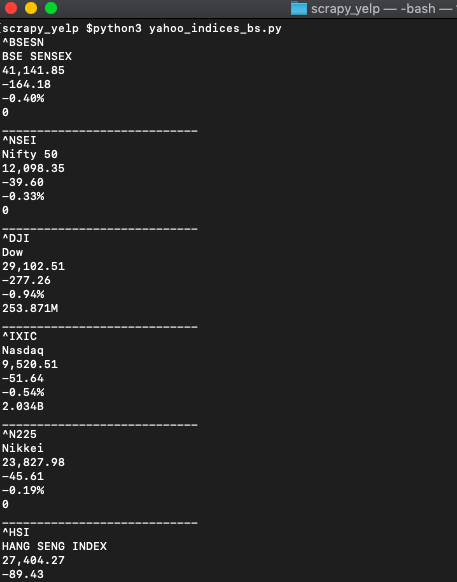Today we are going to see how we can scrape World Indices data using Python and BeautifulSoup in a simple and elegant manner.
The aim of this article is to get you started on a real-world problem solving while keeping it super simple so you get familiar and get practical results as fast as possible.
So the first thing we need is to make sure we have Python 3 installed. If not, you can just get Python 3 and get it installed before you proceed.
Then you can install beautiful soup with...
pip3 install beautifulsoup4
We will also need the libraries requests, lxml and soupsieve to fetch data, break it down to xml and to use CSS selectors. Install them using...
pip3 install requests soupsieve lxmlOnce installed open an editor and type in...
# -*- coding: utf-8 -*-
from bs4 import BeautifulSoup
import requestsNow let's go to the Yahoo World Indices page and inspect the data we can get.
This is how it looks:

Back to our code now... let's try and get this data by pretending we are a browser like this...
# -*- coding: utf-8 -*-
from bs4 import BeautifulSoup
import requests
headers = {'User-Agent':'Mozilla/5.0 (Macintosh; Intel Mac OS X 10_11_2) AppleWebKit/601.3.9 (KHTML, like Gecko) Version/9.0.2 Safari/601.3.9'}
url='https://in.finance.yahoo.com/world-indices'
response=requests.get(url,headers=headers)
print(response)Save this as yahoo_indices_bs.py.
If you run it:
python3 yahoo_indices_bs.pyYou will see the whole HTML page.
Now, let's use CSS selectors to get to the data we want... To do that let's go back to Chrome and open the inspect tool.

We notice that all the individual rows of data are contained in a with the class that begins with 'data-row'. We can get BeautifulSoup to select that data like this.
# -*- coding: utf-8 -*-
from bs4 import BeautifulSoup
import requests
headers = {'User-Agent':'Mozilla/5.0 (Macintosh; Intel Mac OS X 10_11_2) AppleWebKit/601.3.9 (KHTML, like Gecko) Version/9.0.2 Safari/601.3.9'}
url='https://in.finance.yahoo.com/world-indices'
response=requests.get(url,headers=headers)
soup=BeautifulSoup(response.content,'lxml')
for item in soup.select('[class*="data-row"]'):
try:
print(item)
print('------------------')
except Exception as e:
raise e
print('')This prints all the content in each of the rows.
We now can pick out classes inside these rows that contain the data we want. The currencies are in elements with the class which increments from data-col0, data-col1, data-col2. This makes life easy for us.
# -*- coding: utf-8 -*-
from bs4 import BeautifulSoup
import requests
url='https://in.finance.yahoo.com/world-indices'
header = {
'User-Agent': 'Mozilla/5.0 (Macintosh; Intel Mac OS X 10_11_2) AppleWebKit/601.3.9 (KHTML, like Gecko) Version/9.0.2 Safari/601.3.9'
}
response=requests.get(url,headers=header)
soup=BeautifulSoup(response.content, 'lxml')
for item in soup.select('[class*="data-row"]'):
print(item.select('.data-col0')[0].get_text())
print('____________________________')If you run it it will print out all the symbols.

Bingo!! we got the symbols.
Now with the same process, we get the other data like Name, the last price, change, change percentage, volume, etc.
# -*- coding: utf-8 -*-
from bs4 import BeautifulSoup
import requests
url='https://in.finance.yahoo.com/world-indices'
header = {
'User-Agent': 'Mozilla/5.0 (Macintosh; Intel Mac OS X 10_11_2) AppleWebKit/601.3.9 (KHTML, like Gecko) Version/9.0.2 Safari/601.3.9'
}
response=requests.get(url,headers=header)
soup=BeautifulSoup(response.content, 'lxml')
for item in soup.select('[class*="data-row"]'):
print(item.select('.data-col0')[0].get_text())
print(item.select('.data-col1')[0].get_text())
print(item.select('.data-col2')[0].get_text())
print(item.select('.data-col3')[0].get_text())
print(item.select('.data-col4')[0].get_text())
print(item.select('.data-col5')[0].get_text())
print('____________________________')When we run it it will print out every detail we want like this.

We even added a separator to show where each symbol data ends. You can now pass this data into an array or save it to CSV and do whatever you want.
If you want to use this in production and want to scale to thousands of links then you will find that you will get IP blocked easily by Yahoo. In this scenario using a rotating proxy service to rotate IPs is almost a must.
Otherwise, you tend to get IP blocked a lot by automatic location, usage, and bot detection algorithms.
Our rotating proxy server Proxies API provides a simple API that can solve all IP Blocking problems instantly.
- With millions of high speed rotating proxies located all over the world,
- With our automatic IP rotation
- With our automatic User-Agent-String rotation (which simulates requests from different, valid web browsers and web browser versions)
- With our automatic CAPTCHA solving technology,
Hundreds of our customers have successfully solved the headache of IP blocks with a simple API.
The whole thing can be accessed by a simple API like below in any programming language.
curl "http://api.proxiesapi.com/?key=API_KEY&url=https://example.com"We have a running offer of 1000 API calls completely free. Register and get your free API Key here.